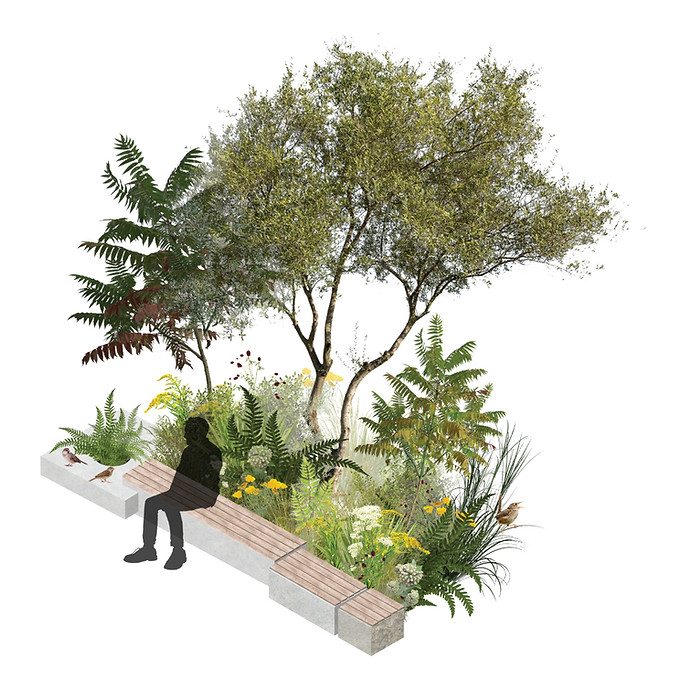
BROOKLYN BRIDGE FOREST
Research, Analysis, Microforests for Pilot Projects // Brooklyn Bridge Forest team
.
PROJECT INTRO
Our Brooklyn Bridge Forest submission was the winner of Van Alen Institute’s competition ‘Reimagining Brooklyn Bridge’, ‘which challenged participants to rethink the iconic Brooklyn Bridge walkway. As made even more clear by the pandemic, the design of our streets and shared spaces must be responsive to the present moment and work to correct past injustices. They must foster equitable, accessible, and sustainable transportation options, create a healthy and safe environment for all New Yorkers, and opportunities for small businesses and vendors to flourish’.
All six finalists, whittled from about 250 entries in a contest held by the New York City Council and urban-design
nonprofit the Van Alen Institute, would turn the 19th-century thoroughfare into a space for culture, lingering and civic engagement. (Excerpt from Wall Street Journal).
Our team of designers, architects, engineers and scientists were brought together by Scott Francisco of Pilot Projects.
Brooklyn Bridge Forest re-imagines the bridge as an icon of climate action and social equity, improving mobility while respecting the landmark structure. The historic wooden walkway is expanded using planks sustainably sourced from a “partner forest” community in Guatemala that protects a 200,000-acre rainforest. A dedicated bike path and reclaimed traffic lane create new space for cyclists and low-carbon transit, while biodiverse “microforests” at either end of the bridge bring nature to New York City and serve as green spaces for underserved communities.
At the heart of this project was the connection to the Guatemalan community through the support of harvested timber for the promenade: timber is harvested from a different portion of the 200,000-acre forest - 1 tree per acre every 40 years - using small-scale equipment and replanting trees in clearings and along roads. The communities’ low-impact timber harvesting provides jobs as well as resources for health and education. These opportunities in turn have given the communities a long-term stake in protecting the forest.
1 // SITE ANALYSIS





Left: Existing vegetation, predominantly parks, in the Brooklyn Bridge area. Roll-over shows potential sites of Microforest implementation, focusing inland away from the waterfront where much of park amenities and development have been focused. NYCHA housing footprints already contain trees - often in fenced-in areas. The total footprint of around 84 acres can be selectively opened up and intensified with vegetation.
Right: Microforests aim to connect existing patches of vegetation. Increasing canopy cover can help reduce energy costs for heating and cooling, a cost-effective way to help the city’s buildings reach the 10% emission reduction goal, aligning with One NYC 2050 sustainability goals.
To lower temperatures up to 10 degrees, canopies need to exceed 40%: a single city block would need to be covered almost half-way with a green network of branches and leaves.
2 // DESIGN


Phase 1 Microforests, at bridge anchors. The Brooklyn side includes a bike ramp to deal with current pedestrian/bike congestion. Choice of vegetation would mimic Eastern Temperate Forest succession with wildflower/grass mixes in clearings, pioneer species and wildflowers for semi (visually) permeable spaces and a deciduous /pine mix in the ramp plaza. Select species would create sound barriers or attract birds for an audio experience, and other areas tie into DEP storm-water management systems - intensifying native rain-garden species.
On the Manhattan side, the current playground would be retrofitted to accommodate forest and gathering spaces, forest patches ‘bleeding’ into fenced off playground for children to access.

Fast Company
This redesign of the
Brooklyn Bridge
involves a
Guatemalan forest.
New York Times
There’s a Global Plan to Conserve Nature. Indigenous People Could Lead the Way.
Surface Magazine
What If the
Brooklyn Bridge Was a Microforest?
The Wall Street Journal
Glass Walkways and Green Spaces: Designers Reimagine the Brooklyn Bridge Experience.
In the Press
MICROFORESTS


Microforests will contain yet a layer of native plantings: Building upon the city’s initiative to include native vegetation, we continue expanding upon the native palette and include species from Eric Sanderson’s Welikia list which identifies and pinpoints ecoregions and native vegetation around the city, pre-European influence.



Native vegetation will support local and ‘traveling’ wildlife, potentially supporting birds such as the Sedge Wren - a native endangered species threatened by habitat loss of wetland and meadows brought on by development.
New York City is situated on the Atlantic Flyway, a migratory route that birds follow during spring and fall migration - flying from as far away as the Arctic to Central and South America.